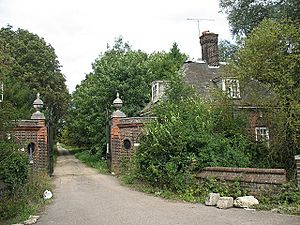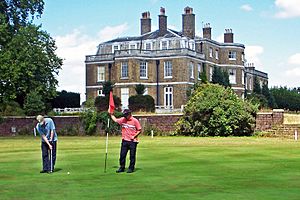Briggens House facts for kids
Briggens House is a historic house from the 1700s located near the village of Roydon in Essex, England. It's a special building that is officially protected because of its history and architecture. The house also has beautiful parklands. Some parts of the gardens were designed by a famous garden designer named Charles Bridgeman way back in 1720. There are also hints of pleasure gardens that were created by Lord Hunsdon in 1908.
Contents
Briggens House: Early Years (1700s)
The first owner of Briggens House was Sir Thomas Foster. Later, his family sold the house to the Crowley family. In 1706, a man named Robert Chester bought Briggens House. He was a director of a big company called the South Sea Company. Robert Chester made many big changes to the house and its gardens. He hired the famous garden designer Charles Bridgeman to work on the grounds.
Briggens House in World War II
During the 1940s, Briggens House played a secret and very important role in World War II. The house was owned by Walter Gibbs, who was the Deputy Chairman of Westminster Bank. From 1941, the Special Operations Executive (SOE) used Briggens House. The SOE was a secret British organization that carried out spy missions and sabotage behind enemy lines. Briggens House became their main place for creating fake documents to help their secret agents and special forces. Even though the War Office took over the house, the Gibbs family was allowed to stay, which was very unusual for such a secret operation.
Training Polish Secret Agents
Briggens House was used to train a special group of elite Polish fighters called the Cichociemni. This name means "Silent and Unseen." These brave soldiers were chosen from the Polish Home Army and had managed to escape to Britain. They learned important skills like hand-to-hand combat, how to sabotage enemy plans, and other secret activities.
After their training, these agents would be dropped by parachute into Nazi occupied Poland. They wore regular clothes and used fake identities and forged papers. Their missions were very dangerous. They had to fly long distances in bad weather over enemy territory, parachute at night, and then find a secret group waiting for them on the ground. Their job was to lead and organize resistance groups against the brutal Nazi forces.
Later, this training unit moved to another location called STS 43 Audley End. This happened because the "False Document Section" at Briggens House needed more space.
The Secret Forgery Team
The "False Document Section," also known as Station XIV, started in the cellar of Briggens House with just three Polish forgers. But it quickly grew! The SOE brought in Britain's most skilled printers, engravers, and artists. This amazing team was led by Captain Morton Grainger Bisset, who was an expert printer.
Their job was to create all kinds of fake documents. These documents helped agents use false identities to work secretly in countries controlled by the enemy without getting caught. They made perfect passports, identity cards, work permits, ration books, and driving licenses. These had to be flawless to trick the Nazi SS and police at checkpoints. Even a tiny mistake could mean instant arrest, harsh questioning, torture, and even execution.
The team made documents for famous agents like Violette Szabo and F. F. E. E. Yeo-Thomas, who was known as the 'White Rabbit'. Experts from Scotland Yard who specialized in handwriting and printing also joined the team. They were so fast that they could often copy documents and return the originals before anyone even noticed they were missing!
The Nazis knew about this secret work. One study even found that the forged ration cards were so good, they were almost impossible to tell apart from the real ones. The team also printed 43 million zloty (Polish money) in 1944. These were dropped into occupied Poland to cause problems for the enemy's economy. By the end of the war, Briggens House had produced an incredible 275,000 forged documents!
Briggens House Today
In 1979, Briggens House was turned into a hotel and conference center. A separate golf club was also set up in the parkland. The hotel closed in 2006. In 2010, it tried to reopen as a wedding venue, but it didn't have the right permission and was quickly closed again. As of November 2019, the house itself is still closed to the public. However, the golf course is still open and being used.
See also
- List of SOE establishments
- Aston House
- The Frythe
- Forgery as covert operation




